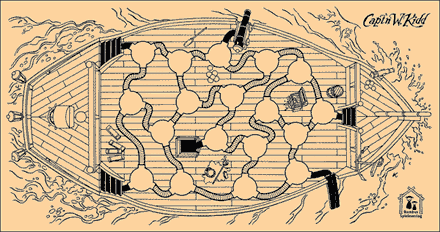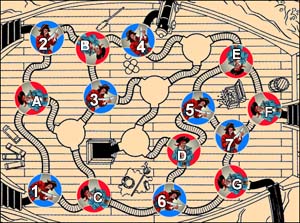|
|
|
by Günter Cornett (co-designed by Volker Schäfer)
graphics by Dietmar Krüger
rules translation by Rick
Heli
Content
Common Rules
Loyal Captain for 2 players aged 10 and up
Opposing pirates encircle. It's not as simple as it looks.
Quedah Merchant for 2 players aged 9 and up
Attack from behind - with tactical skill and luck of the dice.
Madagascar for 2-3 players aged 10 and up
Wild bunches swarm across the deck,
becoming ever larger and stronger.
Game Components
-
24 Game Tokens:
- 21 Pirates (7 in each of 3 colors)
- 3 Pirate Flags (only needed for the Madagascar game.)
 Stickers
must be applied to the tokens before the first game. Stickers
must be applied to the tokens before the first game.
The pirate flags go on the dark tokens.
-
1 Game Board showing 18 spaces connected by paths:
 12 of the spaces are each connected to 3 other spaces.
12 of the spaces are each connected to 3 other spaces.
The remaining 6 spaces are the Start spaces.
(They are each connected to two neighboring spaces.)
-
1 Six-sided die showing values 1-3
(only needed for the Quedah Merchant game)
General Rules
Placing tokens:
A token enters the game by being placed on one of the six Starting spaces. It is
placed so that the bottom side of the pirate abuts the black path of the space
and the background graphic of the token is continuous with the two other paths
leading out of the space.
Movement:

Basically a token can be moved forward out of its space in one of two possible
directions, but never backwards. Rotating the token on a space is also not
allowed. After movement, the pirate is placed so that the bottom side matches
up with the path over which it traveled.
When in the further course of the game, a token is moved into one of the
Starting spaces, one of its paths will lead off the board. However, it is not
permitted to leave the board. In this case there is only one movement option.
|
Loyal Captain
Capt'n W. Kidd refuses to capture the Loyal Captain since his ship sails under
the British flag. For the first time the crew mutinies! without success this
first time, however.
The Rules in Brief:
-
Each player has 7 tokens in their color available.
-
The players take turns each moving one of their tokens (either: place a new one
or: move 1 from a space to an adjoining space).
-
Tokens, or groups of tokens, which are threatened by opposing pirates on all
sides are captured and removed from the game. A token threatens another if it
could theoretically move onto it on its next turn.
-
A player who cannot move or place any tokens loses the game.
Tactical Hints and Rules Clarifications:
Re 2: At the start of the game it's a good idea to bring on as many
tokens as possible as a strong board presence offers more opportunities to move
and capture. But in doing so take care that one's pieces are not surrounded by
the opposition.
On the other hand, near the end of the game it is a great advantage if one
still has one (or two) tokens in reserve and available for placement.
Tokens must always be moved forward to the next space. The token is oriented so
that its back points to the space from which it came. Since rotation on a space
is forbidden, it cannot be returned directly back to the space from which it
came. In addition, no token may be moved into an occupied space.
Re 3: Capture via surrounding.
If an individual token is surrounded by three opposing tokens, which could
theoretically reach its space on its next turn, it is captured. A token on a
Starting space is captured by just two opponent tokens. Captured tokens are
removed from the game.
Connected, same color groups of tokens are captured if every space connected to
this group is occupied by an opposing pirate, each of which does not point to a
group member with its bottom side. But if even a single connected space is
vacant or occupied so that the bottom side of the token points to the group,
the group is not captured. Thus, as in the classic game Go, leave internal
holes to protect a group. Since tokens cannot be placed just anywhere, a single
hole is often sufficient to secure a group.
On the other hand, a player is occasionally dissolved out of his secure
position since he has to move exactly one token every round (or place a new one
on a Starting space).
A further method of protection is to move behind an opposing token because as
long as the opposing token presents its back, your token cannot be captured.
However, it is possible to lose the game due to inability to move.

1 is captured by C and A.
B is captured by 2, 3, and 4.
5 and 7 are captured as a group by D, E, F, and G.
E and F are not captured since there is a vacant space connected to E.
2 is not captured even though B indeed is adjacent, but 2 is not threatened.
Similarly, G is not threatened by 7 and 6 is not threatened by C and D.
If a token is placed on a space which is already threatened by two opposing
tokens, the newly-placed piece is immediately captured. Exception: if by this
placement at least one of the two other tokens is captured, then the placed
token is not captured.
Re 4: End of the Game
A player unable to move (or place) any pieces loses.
In certain situations it can happen that neither of the players can prevent the
others from moving. In this case the players agree to a stalemate.
A stalemate is usually clearly recognizable by both players. If there is
disagreement over a stalemate, then the player rejecting it has twenty more
turns to prove their point by actually managing a win. If they do not succeed in
defeating the opponent in twenty turns, they lose the game.
If during this twenty turn period a token is captured, the turn count begins
anew.
Start-up Variant:
One player decides the placement position of each of the first tokens for both
sides, then the other chooses which of these pieces, and hence the color, to play as.
|
Quedah Merchant
A few days after the capture of the Quedah Merchant, it is revealed to be a British
ship. Capt'n. W. Kidd wants to return it; his crew prevents him from doing
this.
Game Components:
Each player has the 7 tokens of a color available.
In addition the die is required.
Starting the game:
Each player in turn order places a token on a vacant Start space of their
choice.
Game Turn:
The players take turns rolling the die and moving a token the resulting amount
(1-3). All of the dice pips must be used. Jumping over other tokens is not
permitted. Whenever a player moves a token off a Starting space, they place a
new token on the vacant Starting space of their choice (if any of their tokens remain).
Capturing Opponent Pirates:
It's permitted to move on to an opposing token if the space is connected via its
back (that is, from behind). But even here all dice pips must be used.
This token is now captured and taken along with every subsequent move of the
token resting on it. Its owner is no longer allowed to move it. A token which
has a captured token cannot capture any further token.
A token may never move on top of a token of the same color.
Freeing a Friendly Pirate:
If one's pirate moves from behind onto an opposing pirate who holds a friendly
pirate captive, the captive is freed and the opposing pirate is captured
instead.
The freed token immediately moves to one of the two available spaces to which it
could normally move, if either are free. If such a space is occupied by an
opposing token whose back faces the freed token, then this latter token may
move on to it and take it prisoner (and free a further token, etc.). But if
both possible escape spaces contain friendly tokens (and/or opponent tokens
facing the opposite direction), then the original freeing token is not
permitted to take this action.
End of the Game:
The game ends when
-
seven tokens (of either color) are captured, or
-
a player is not able to move any tokens
Victory:
In case of (a), the player who has captured more tokens wins. In case of (b) the
winner is the player who made the last move.
Tactical Tips:
Blocking opposing tokens is more important than capturing them. If a token is
blocked on its Starting space, the player cannot bring in any new pieces since
this is only allowed after a Starting space has been vacated.
|
Madagascar
Off Madagascar, matters finally come to mutiny. The majority of Capt'n. W. Kidd's
crew go over to his old adversary, Robert Culliford.
Game Components:
Each player has the 7 tokens of a color available (6 tokens in a three-player
game). The three black pirate flags are kept handy near the game board.
Starting the game:
In turn, each player places one of their tokens on a Starting space (until all of
the Starting spaces are occupied).
Game Turn:
The player taking a turn has the choice to either move a token or place one on a
vacant Starting space. If neither is possible, they pass.
Capturing Opponent Pirates:
It's possible to move on top of an opponent's token if it is reached from a
space connected to its back. The token below is now captured and taken along
with every move of the token above it. A token which has captured another may
capture further tokens to form a "tower" of tokens. Towers may also
be captured in the same way.
It is never allowed to move directly on top of one's own tokens, although
certainly one's own tokens may be present lower in the tower.
Movement Distance:
The distance that a tower of tokens moves depends on the number in the stack.
For example, a tower of three tokens must move exactly 3 spaces.
Important: Never move over other pieces.
As play continues, towers can become rather high. Once the height reaches 6
pirate tokens, it's a good idea to replace the lower five tokens with a flag
token. This does not reduce the movement distance of the tower.
End of the Game:
The game ends when one player has captured all of the opposing tokens. This
player wins. Should it not be possible to capture all of the tokens (e.g.
because of inability to move), the game ends in a stalemate.
The game also ends in stalemate should the same position be repeated three
times.
Tactical Tips:
Opening Phases:
The first pirate to leave its Starting space is immediately threatened by the
pirate which is next placed on this space. If this piece afterwards moves, the
pursued piece cannot create enough distance. It is therefore a good idea to
maneuver the pursued pirate into a blind alley so that pursuit is unappealing.
If the pursuer captures the piece anyway, they must then reckon with their piece
itself being captured.
High Towers:
High towers can move a long way as long as they have an open road. But in the
beginning paths are mostly quite blocked so they constitute easy targets.
Toward the end of the game, owning a high tower is, as a rule, a requirement
for victory.
|
| |